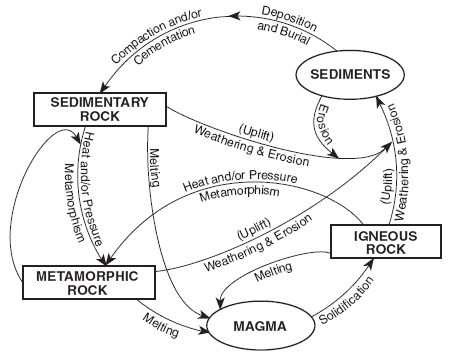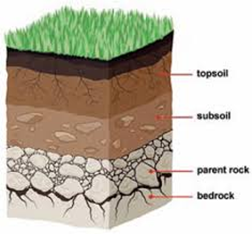Describe the difference between weathering, erosion, and deposition?
Weathering - breakdown of rock
Erosion - movement of rock
Deposition - dropping of rock
If you observe layers, what type of rock are you likely looking at?
sedimentary (metamorphic would be BANDS/FOLIATION)
What are the 3 classes of rock?

igneous, metamorphic, sedimentary
If a rock with layers undergoes heat and pressure, then it will become what type of rock?
A metamorphic rock
The image below shows a piece of the Earth's crust. The formation of rock fragments was likely a result of which process?

weathering
This feature may be seen in metamorphic rocks
Bands/Foliation
What process is required to create sediments?
Weathering and erosion
How do sedimentary rocks form?
sediments are compacted or cemented together
Below are before and after pictures of an island. Explain what process formed the feature highlighted in red, and explain how you know.
Erosion - the sediments (sand) are gone now and have been moved, water has taken its place.
Refer to google doc (which is a mineral, which is a rock?)
Object A = rock (mixture of different things)
Object B = mineral (only one substance/uniform composition)
Magma becomes ______________ through solidification. What is solidification? Fill in the blank, then describe what solidification is.

Igneous rock - solidification is when magma cools off, and becomes a solid instead of a liquid
What are the 2 types of igneous rock?
intrusive and extrusive
see question on google docs
waves will erode the arch over time making it smaller
List 2 observations you see in the rock below, and then infer what type of rock you are probably looking at BASED ON THOSE OBSERVATIONS.
1) layers
2) shells/fossils
Sedimentary rock
Describe ALL the steps and stages necessary for a sedimentary rock to become an igneous rock

First it will have to melt into magma, then solidify into an igneous rock.
How can you tell apart an intrusive igneous rock from an extrusive igneous rock? How did each form?
Intrusive - forms in the earth, undergound
Extrusive - forms outside the earth, above ground
* see doc for image
Observe the changes between stage 1 to stage 2. What process is this, and how do you know?
Observe the changes between stage 3 and stage 4. What process is this, and how do you know?
Stage 1 to 2 = deposition, because new layers were dropped on top of original ones
Stage 3 to 4 = erosion, the top layer was moved and is in a new location (no longer there).
One igneous rock has vesicles, the other igneous rock has crystals. Though both rocks are igneous rocks, they have different characteristics. Explain why.
The one with vesicles likely cooled above ground and cooled quickly. The one with crystals likely cooled below ground and cooled slowly.
List ALL the steps and stages that would have to occur in order for a metamorphic rock to become a sedimentary rock.

Using the diagram below, describe which letter would have each type of rock (metamorphic, intrusive igneous, extrusive igneous, and sedimentary) located there, and how you know.
A = extrusive igneous (top of volcano, not underground)
B = intrusive igneous (inside earth, underground by volcano)
C= sedimentary (exposed to wind, water)
D = metamorphic (close to center of earth which is hot, has weight on top of it)
